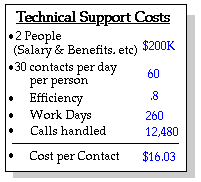![]()
Approaching the Market: Support
Providing good technical support is one way to ensure customer loyalty, however this is a tricky area to navigate. Your core strength probably lies in writing good software and technical support has the potential to soak up a lot of your time. Similar to the "Transaction" section of this document, you've really got two choices. You can do it yourself or look for outside help
Do it Yourself
When considering to handle Technical Support yourself, you might consider that the average contact rate for software companies is higher than 35%. That means for every 100 copies of your software that you sell, you can expect 35 questions. Using our earlier transaction numbers, if you sold 7,000 copies of your software, you'd need to be able to handle 2,450 support calls, AND still get that next version done.
 Another industry estimate is that one full time
support person can handle approximately 6,000 calls a year and that doesn't
take into account vacations, sick time, and the dreaded jury duty. Remember,
those Technical Support questions don't take vacations, they keep rolling
in.
Another industry estimate is that one full time
support person can handle approximately 6,000 calls a year and that doesn't
take into account vacations, sick time, and the dreaded jury duty. Remember,
those Technical Support questions don't take vacations, they keep rolling
in.
You can use the table to the left as a general guide to costs for running your own Technical Support department.
If you've decided to forge ahead and start by providing Technical Support yourself, here are a few things to consider.
FAQs, FAQs, FAQs
Your best candidate for Technical Support is the end user themselves. Do full serve only gas stations even exist anymore? People like to help themselves. Empower the end user to find solutions on their own time by providing Frequently Asked Questions documents online.
Web
Using a web-based interface for Technical Support will speed up the initial process. You can control what information the end user supplies so you'll know what kind of machine they are using, the peripherals attached, software versions, in what time zone they are located, and a thought out typed description of the problem. You may be able to answer their question immediately and electronically with the information collected from a web based form.
Phone
Finally, there's the traditional method of phone-based Technical Support. Use the numbers above to help figure out your potential costs. If you don't plan to offer extended Technical Support hours, you'll probably want to employ some of the other methods as well.
Third Party Support
You might also consider having a third party handle your Technical Support calls. Be has been looking at this method of Technical Support to handle the coming wave of end users we are expecting to garner this year. Outsourcing your Technical Support will not allow you to simply forget about Technical Support, you'll need to manage your third party Technical Support. Below is a table that is indicative of the bids we've received to handle Technical Support.
Contacts Per Day |
Number of People |
Price per Minute |
Price per Contact |
50 |
3 |
$1.70 |
$13.60 |
100 |
5 |
$1.40 |
$11.20 |
150 |
7 |
$1.30 |
$10.40 |
200 |
8 |
$1.15 |
$9.20 |
250 |
10 |
$1.10 |
$8.80 |
300 |
11 |
$1.05 |
$8.40 |
450 |
14 |
$0.99 |
$7.92 |
By comparing the table above to the cost estimates of running your own Technical Support department, you'll notice significant potential savings in this area. Keep in mind that although you may outsource your Technical Support, this is only first line support which may need to supplemented by second line support providing by a knowledgeable member of your technical staff.
This paper has provided an introduction of areas to consider when bringing your BeOS software to market. The information contained in the paper is intended as a guide only, so the figures (and mileage) presented may vary depending on your location, type of software, and many other factors. The Be Evangelists' goal is to make it easier for you to bring your software to market. Please don't hesitate to contact them for help in these areas.
Approaching the Market Index